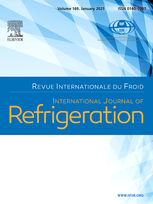
Document IIF
Optimisation des performances de refroidissement et de la consommation d'eau d'un système de refroidissement évaporatif indirect assisté par dessiccant solide en utilisant la méthodologie de surface de réponse.
Optimisation of cooling performance and water consumption of a solid desiccant-assisted indirect evaporative cooling system using response surface methodology.
Auteurs : LAI L., WANG X., KEFAYATI G., HU E., KIM C. N.
Type d'article : Article de la RIF
Résumé
Solid desiccant-assisted dew-point indirect evaporative cooling (SD-DPIEC) systems have gained considerable attention as a potential eco-friendly alternative to vapour-compression cooling systems in building cooling applications. However, one major drawback of these systems is their substantial water consumption during evaporative cooling. To tackle this issue, this study aims to improve the cooling efficiency and water utilisation of an SD-DPIEC system using response surface methodology (RSM). This research focuses on optimising four key parameters: supply air temperature, humidity ratio, water consumption rate and coefficient of performance (COP). The independent variables encompass the ambient temperature, relative humidity, regeneration temperature, and recirculation air ratio. Employing a multi-objective optimisation approach via the desirability function, the optimised SD-DPIEC system is subsequently tested in two prevalent weather patterns in Australia. The results demonstrated that the regression models derived from RSM exhibited commendable predictive capability, with the determination coefficient and Adequate Precision exceeding 0.97 and 40.46, respectively. The outcomes revealed that the system attained its optimal performance with a supply air temperature of 20.36 °C, humidity ratio of 12.56 g kg-1, a water consumption rate of 3.11 kg/hr, and COP of 2.03 under the ambient temperature of 33.79 °C, relative humidity of 68.48 %, regeneration temperature of 51.78 °C, and recirculation air ratio of 60 %. Based on the optimisation results, a case study was undertaken to evaluate the system's applicability in representative Australian climates. The results demonstrated that the system could uphold air conditions with the supply air temperature below 19 °C and humidity ratio below 11.51 g kg-1 under the studied Australian climates.
Documents disponibles
Format PDF
Pages : 376-388
Disponible
Prix public
20 €
Prix membre*
Gratuit
* meilleur tarif applicable selon le type d'adhésion (voir le détail des avantages des adhésions individuelles et collectives)
Détails
- Titre original : Optimisation of cooling performance and water consumption of a solid desiccant-assisted indirect evaporative cooling system using response surface methodology.
- Identifiant de la fiche : 30032867
- Langues : Anglais
- Source : International Journal of Refrigeration - Revue Internationale du Froid - vol. 168
- Date d'édition : 12/2024
- DOI : http://dx.doi.org/10.1016/j.ijrefrig.2024.09.023
Liens
Voir d'autres articles du même numéro (63)
Voir la source
-
Exergy analysis of a liquid desiccant evaporati...
- Auteurs : PENG D., ZHOU J., LUO D.
- Date : 10/2017
- Langues : Anglais
- Source : International Journal of Refrigeration - Revue Internationale du Froid - vol. 82
- Formats : PDF
Voir la fiche
-
Modeling and multi-objective optimization of an...
- Auteurs : SOHANI A., SAYYAADI H., HOSEINPOORI S.
- Date : 09/2016
- Langues : Anglais
- Source : International Journal of Refrigeration - Revue Internationale du Froid - vol. 69
- Formats : PDF
Voir la fiche
-
Combining liquid desiccant dehumidification wit...
- Auteurs : WOODS J., KOZUBAL E.
- Date : 08/2013
- Langues : Anglais
- Source : HVAC&R Research - vol. 19 - n. 6
Voir la fiche
-
Feasible study of a self-cooled solid desiccant...
- Auteurs : GE T. S., DAI Y. J., WANG R. Z., et al.
- Date : 01/2013
- Langues : Anglais
- Source : Applied Thermal Engineering - vol. 50 - n. 1
Voir la fiche
-
Experimental investigation and analysis of comp...
- Auteurs : JIANG Y., GE T. S., WANG R. Z., et al.
- Date : 03/2015
- Langues : Anglais
- Source : International Journal of Refrigeration - Revue Internationale du Froid - vol. 51
- Formats : PDF
Voir la fiche
